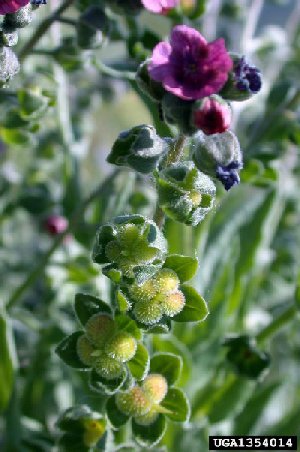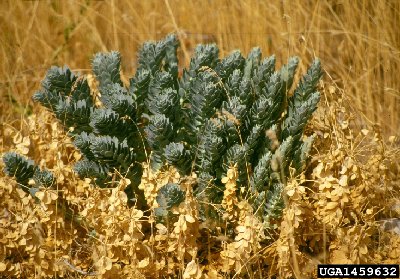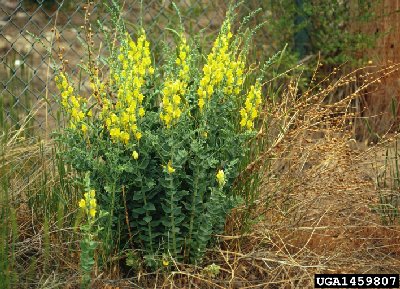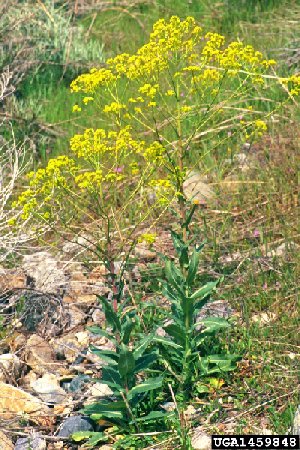Noxious Weeds
Neal Dombrowski, Horticulturist
Red Butte Garden and Arboretum staff has been managing the Natural Area within and adjacent to our perimeter fence for decades. Staff and volunteers spend many hours each year pulling and treating non-native weeds in the Natural Area to support the local native plants and ecosystem.
We focus on several species that are non-native to our area, and prioritize weeds as listed as noxious by the state of Utah. Noxious weeds are plants that are non-native and are legally listed (by a municipality) as having significant impacts to native habitat, public health, agriculture, horticulture, recreation, or livestock, and ultimately have significant adverse effects on local ecosystems and the economy.
What
Several species we have been controlling around the Garden and Natural Area include:
- Cutleaf Vipergrass (Scorzonera laciniata), class IB
- Dalmatian Toadflax (Linaria dalmatica), class II
- Dyers Woad (Isatis tinctoria), class II
- Field Bindweed (Convolvulus arvensis), class III
- Garlic Mustard (Alliaria petiolata), class IB
- Houndstongue (Cynoglossum officinale), class III
- Jointed Goatgrass (Aegilops cylindrica), class III
- Myrtle Spurge (Euphorbia myrsinites), class IV
- Scotch Thistle (Onopordum acanthium), class III
- Whitetop or Hoary Cress (Lepidium draba), class III
Additional species have the potential to impact our landscapes, but are not established at the Garden include:

Houndstongue, Mary Ellen Hart, bugwood.org

Myrtle Spurge, Steve Dewey, Utah State University

Dalmation Toadflax, Utah State University

Dyers Woad, Steve Dewey, Utah State University
How
Opportunities for weeds to spread and establish are dependent on a number of environmental conditions such as plant distribution, proximity to other plants, soil disturbance, the transportation of people and products, and/or resources including water, soil minerals, temperature, and light.
When controlling weeds, the first step is to make sure you’re correctly identifying the plant! Education and rapid response can prevent new weeds from becoming established, reducing future control needs.
Noxious weed species respond uniquely to control methods and may require a combination of strategies for successful control. Integrated Pest Management (IPM) is an effective and environmentally sensitive approach to pest management relying on a combination of control methods. There are typically six methods used to manage noxious weeds in an IPM Plan: biological, chemical, cultural, genetic, mechanical/physical, and regulatory.
Consistent, multi-year treatments are necessary to control noxious weed populations. The dyer’s woad plant, for example, can produce several hundred seeds per year! Their seeds stay viable in the soil for many years waiting for the right climatic conditions to germinate and grow.
Some weeds, such as myrtle spurge, garlic mustard, and others, require physical removal from the site, as they can re-root under the right conditions, or underdeveloped seed can still mature on the plant if left on the ground.
Whitetop and field bindweed have extensive and vigorous creeping root systems that may be difficult to control by digging/pulling alone. Portions of roots left behind in the soil will regrow or be stimulated to produce more growth.
Myrtle spurge contains a caustic milky sap that is toxic to humans. Those pulling or handling these plants should wear gloves and eye protection. For more information on the safe removal of myrtle spurge, refer to the Salt Lake County Weed Control Program.
Garden staff controls the majority of these weeds by mechanical removal in the spring before they set seed, when the plants are small and the soil conditions are favorable. Depending on the life cycle and root structure of a weed species, we will utilize a variety of control methods for effective control.
Resources
Utah’s Noxious Weed List is maintained by the Utah Department of Agriculture and Food.
The list includes 54 species, within 4 categories:
Class 1: Early Detection Rapid Response (EDDR). These species are not known or new to the state; rapid detection and removal is a high priority to prevent them from becoming established in the state.
Class 2: Control. These species have known populations in the state, in which control and eradication may be possible.
Class 3: Containment. Treatment for these species focuses on minimizing the spread of existing populations and eliminating new populations.
Class 4: Prohibited. These species pose a threat through their sale in the green industry.
Utah State University published a Noxious Weed Field Guide for Utah. The online Field Guide includes the list of noxious weeds by class, descriptions, images, control methods, and a distribution map.
If you suspect noxious weeds in your area, you can report it to:
- Salt Lake County Weed Control Program, or
- EDDMapS - a free app platform where anyone can record observations about weeds which will be verified by professionals. The app allows you to download a photograph of the weed for verification, and ‘drop a pin’ to share its location.
Another Resource is the Utah Weed Control Association.
For Certified Pesticide applicators, more information and IPM methods can be found in the National Pesticide Applicator Certification (NPAC) Core Manual